Wincle
OS Grid ref:- SJ 841 786
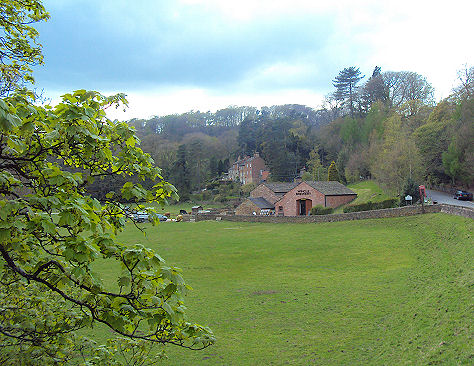 The isolated but picturesque village of Wincle straddles the River Dane which separates Cheshire from Staffordshire.
The isolated but picturesque village of Wincle straddles the River Dane which separates Cheshire from Staffordshire.
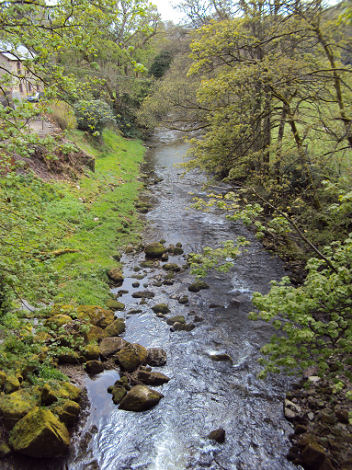 The village boasts spectacular moorland views across to the Roaches, Shutlingsloe and Hanging Stone as well as lush woodland and drystone-walled pasture land. The surrounding scenery makes Wincle a much favoured spot with walkers.
The village boasts spectacular moorland views across to the Roaches, Shutlingsloe and Hanging Stone as well as lush woodland and drystone-walled pasture land. The surrounding scenery makes Wincle a much favoured spot with walkers.
St Michaels Church at Wincle was originally built in 1647 and occupies the site of a Neolithic burial mound.The gritstone tower was added in around 1815, and the rest of the church was rebuilt in 1882 by Edward Witts.
The sandstone Ship Inn, near the River Dane, serves real ales and good food. Once three stone cottages, with walls three feet thick, part of the building dates back to the sixteenth century.
The inn sign depicts Shacketon's Nimrod. The Brocklehurst's were local gentry, one of whom, Sir Phillip Brocklehurst, accompanied the explorer on his mission to the Antartic aboard the Nimrod. The Ship Inn Beer Festival is held annually over the August bank holiday weekend.
Legend states that in December 1745, during the second Jacobite rebellion, in the course of Bonnie Prince Charlie's ill fated retreat from Derby back to the Highlands of Scotland, one Alexander Maclean, a highlander and a straggler from the prince's army, stopped at the Ship Inn, demanding food. The wily innkeeper waited his chance and suceeded in snatching Mclean's musket while he was eating. The renegade was then held at gunpoint until the arrival of Sir Peter Davenport, the local magistrate.
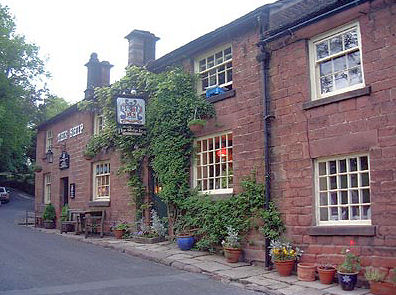 The highlander's weapon was left at the Ship Inn (pictured right) and used to be kept on display behind the bar, it was later believed to have been sold to the Brocklehurst family. It is thought that some of the Highlanders were hung from the Hanging Stone at the end of the nearby rocky escarpment known as the Roaches.
The highlander's weapon was left at the Ship Inn (pictured right) and used to be kept on display behind the bar, it was later believed to have been sold to the Brocklehurst family. It is thought that some of the Highlanders were hung from the Hanging Stone at the end of the nearby rocky escarpment known as the Roaches.
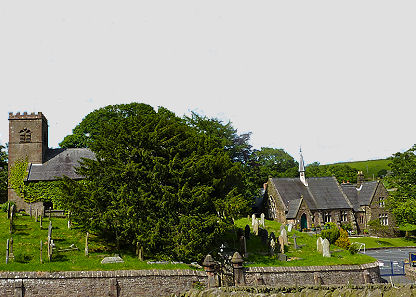 Bonnie Prince Charlie himself is reputed to have spent the night at Royal Cottage during his retreat from Derby, the building is situated on the main Leek to Buxton road past the Winking Man pub. It was at that time an inn. The field behind the cottage is known as Bareleg hill, it is thought that Bonnie Prince Charlie's army camped there. The 'bareleg' being a reference to the Highland kilts.
Bonnie Prince Charlie himself is reputed to have spent the night at Royal Cottage during his retreat from Derby, the building is situated on the main Leek to Buxton road past the Winking Man pub. It was at that time an inn. The field behind the cottage is known as Bareleg hill, it is thought that Bonnie Prince Charlie's army camped there. The 'bareleg' being a reference to the Highland kilts.
Five standing stones are situated at the western edge of Minn End Lane, they stand by the Griststone Trail, a popular long distance trail which runs for 35 miles from Disley to Kidsgrove, the trail is split into three stages and encompasses some of the finest scenery in Cheshire.
Three of the stones are believed to be prehistoric, while the other two are suspected to be more recent additions. Some have holes drilled in them indicating that they might once have been gate posts marking the line of a fence which no longer exists. The stones are best accessed on foot along Minn End Lane which follows the spine which separates Bosley Minn from Wincle Minn.
Nearby Swythamley Hall stands in parkland and was originally a mediaeval hunting lodge belonging to the Abbey of Dieulacres. King Henry VII gave the hall to the Trafford family in 1540, it was eventually inherited by the Brocklehursts. The original hall burned down, the present building dates to 1813. The name derives from the Old Norse word svitha, meaning land cleared by burning and another Old Norse word holmr, or its English equivalent, meaning raised ground in marsh land.
The Clulow Cross
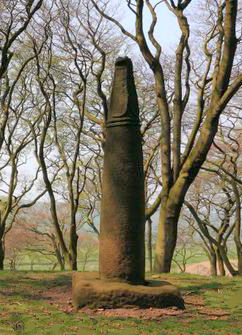 In a patch of woodland to the north of the village and just over the A54, lies Cleulow cross (OS grid reference- SJ952674), a ninth century high cross and scheduled ancient monument. Nothing is known of its origin or purpose, but it may have been a boundary marker.
In a patch of woodland to the north of the village and just over the A54, lies Cleulow cross (OS grid reference- SJ952674), a ninth century high cross and scheduled ancient monument. Nothing is known of its origin or purpose, but it may have been a boundary marker.
The broken millstone grit pillar stands about 10 feet high on a large conical mound, measuring 250 feet in diameter and 25 feet high, some authorities believe it to be a round barrow and it is located a short distance from the junction of two ancient long distance trails.
The cross consists of a large base and shaft with the remains of a small wheelhead cross on the top. The cross is of late Anglo-Saxon origin and is one of a group of round shafts in this area. The base incorporates a small hollow which may have been made in the seventeenth century to facilitate the use of the cross as a plague stone.
The Clulow Cross is the scene of the climax of the book "The Weirdstone of Brisingamen" written by Cheshire novelist Alan Garner who lived at Alderley Edge.
Nearby is another ancient monument known as the Bullstones. A Bronze Age stone circle, the millstone grit cobbles surrounds a single, central monolith. The monument stands on the eastern side of Brown Hill, at the rear of Sandyway Farm. The stones are located just off a public right of way a couple of hundred metres from a nearby lay-by.
Nearby places of interest
Lud's Church is an immense natural cleft in the rock on the hillside above Gradbach. The cleft, which is 15 metres high in places and over 100 metres long, has been formed by a landslip which has detached a large section of rock. Over the centuries, Lud's Church has offered shelter to all sorts of fugitives, there are legends that both Robin Hood and Bonnie Prince Charlie used it.
Three Shires Head, is a beauty spot where the three counties of Derbyshire, Cheshire and Staffordshire meet.
Macclesfield Forest, once the centre of a Royal Forest created by the Norman kings for the purpose of hunting game such as deer, wild boar and wolves. It once encompassed all the area from Disley to the River Dane. The forest is home to a herd of red deer, while the reservoirs contain a wide variety of wildfowl.
Shutlingsloe is the third highest peak in the Cheshire (Shining Tor being the highest and Whetstone Ridge the second ) with an elevation of 506 metres (1,660 feet), the summit offers excellent views. On a clear day the mountains of North Wales are visible from its summit.
